An In-Depth Analysis of Interest Rate Cuts and Economic Implications
VerifiedAdded on 2022/12/16
|8
|1715
|496
Report
AI Summary
This report examines the economic implications of interest rate cuts, focusing on their impact on aggregate demand, aggregate supply, and overall economic growth. It analyzes how weak wage growth influences economic indicators and explores the effects of interest rate cuts on investment, consumption, and net exports. The report also delves into the impact of interest rate cuts on the labor market, particularly the implications of increasing part-time work and the relationship between the natural rate of unemployment (NAIRU) and the long-run aggregate supply (LRAS). Additionally, it discusses the consequences of incorrectly estimating NAIRU and the role of the Reserve Bank of Australia (RBA) in monetary policy, providing a comprehensive analysis of interest rate cuts and their effects on the Australian economy. The report uses economic models and graphs to illustrate key concepts and relationships.
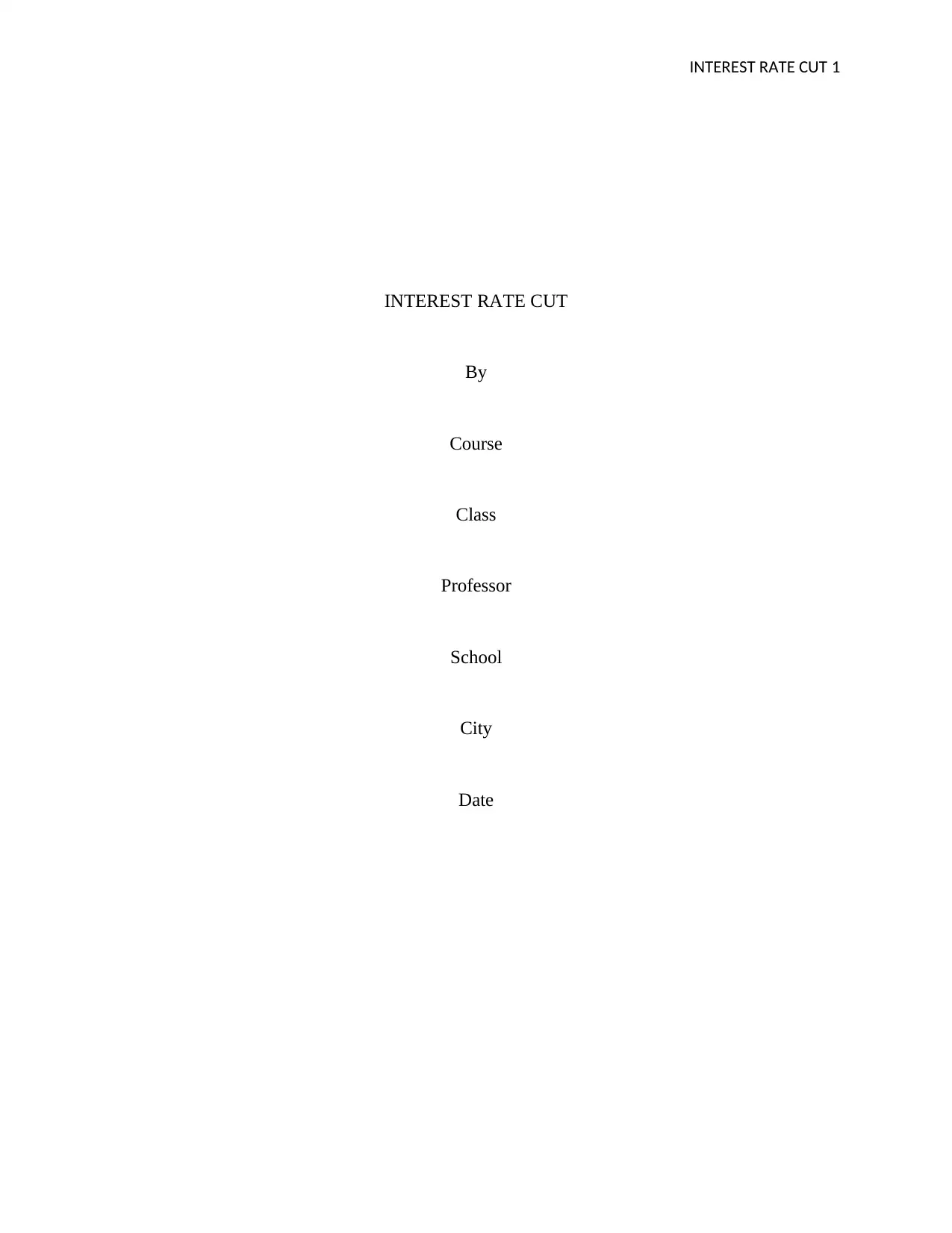
INTEREST RATE CUT 1
INTEREST RATE CUT
By
Course
Class
Professor
School
City
Date
INTEREST RATE CUT
By
Course
Class
Professor
School
City
Date
Paraphrase This Document
Need a fresh take? Get an instant paraphrase of this document with our AI Paraphraser
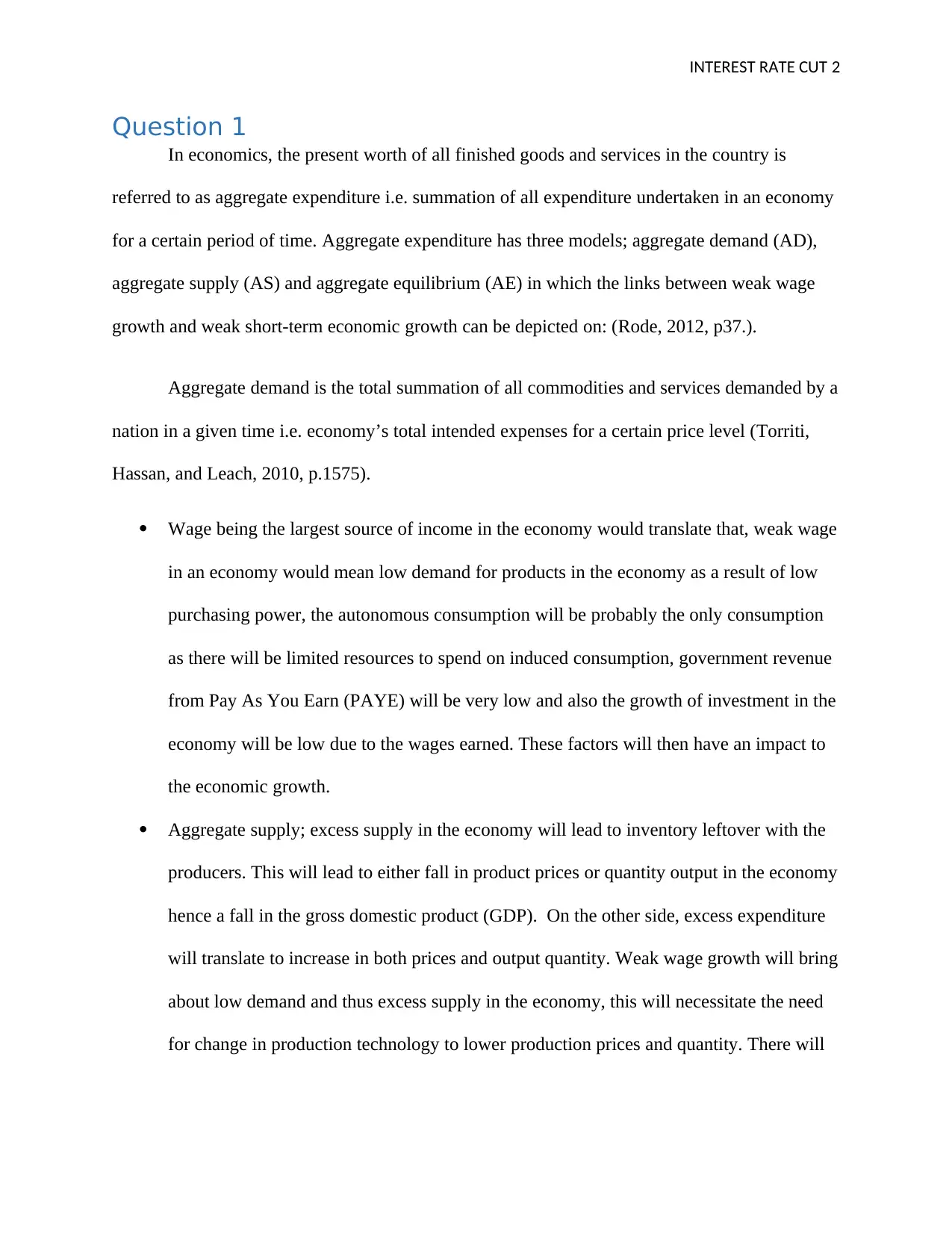
INTEREST RATE CUT 2
Question 1
In economics, the present worth of all finished goods and services in the country is
referred to as aggregate expenditure i.e. summation of all expenditure undertaken in an economy
for a certain period of time. Aggregate expenditure has three models; aggregate demand (AD),
aggregate supply (AS) and aggregate equilibrium (AE) in which the links between weak wage
growth and weak short-term economic growth can be depicted on: (Rode, 2012, p37.).
Aggregate demand is the total summation of all commodities and services demanded by a
nation in a given time i.e. economy’s total intended expenses for a certain price level (Torriti,
Hassan, and Leach, 2010, p.1575).
Wage being the largest source of income in the economy would translate that, weak wage
in an economy would mean low demand for products in the economy as a result of low
purchasing power, the autonomous consumption will be probably the only consumption
as there will be limited resources to spend on induced consumption, government revenue
from Pay As You Earn (PAYE) will be very low and also the growth of investment in the
economy will be low due to the wages earned. These factors will then have an impact to
the economic growth.
Aggregate supply; excess supply in the economy will lead to inventory leftover with the
producers. This will lead to either fall in product prices or quantity output in the economy
hence a fall in the gross domestic product (GDP). On the other side, excess expenditure
will translate to increase in both prices and output quantity. Weak wage growth will bring
about low demand and thus excess supply in the economy, this will necessitate the need
for change in production technology to lower production prices and quantity. There will
Question 1
In economics, the present worth of all finished goods and services in the country is
referred to as aggregate expenditure i.e. summation of all expenditure undertaken in an economy
for a certain period of time. Aggregate expenditure has three models; aggregate demand (AD),
aggregate supply (AS) and aggregate equilibrium (AE) in which the links between weak wage
growth and weak short-term economic growth can be depicted on: (Rode, 2012, p37.).
Aggregate demand is the total summation of all commodities and services demanded by a
nation in a given time i.e. economy’s total intended expenses for a certain price level (Torriti,
Hassan, and Leach, 2010, p.1575).
Wage being the largest source of income in the economy would translate that, weak wage
in an economy would mean low demand for products in the economy as a result of low
purchasing power, the autonomous consumption will be probably the only consumption
as there will be limited resources to spend on induced consumption, government revenue
from Pay As You Earn (PAYE) will be very low and also the growth of investment in the
economy will be low due to the wages earned. These factors will then have an impact to
the economic growth.
Aggregate supply; excess supply in the economy will lead to inventory leftover with the
producers. This will lead to either fall in product prices or quantity output in the economy
hence a fall in the gross domestic product (GDP). On the other side, excess expenditure
will translate to increase in both prices and output quantity. Weak wage growth will bring
about low demand and thus excess supply in the economy, this will necessitate the need
for change in production technology to lower production prices and quantity. There will
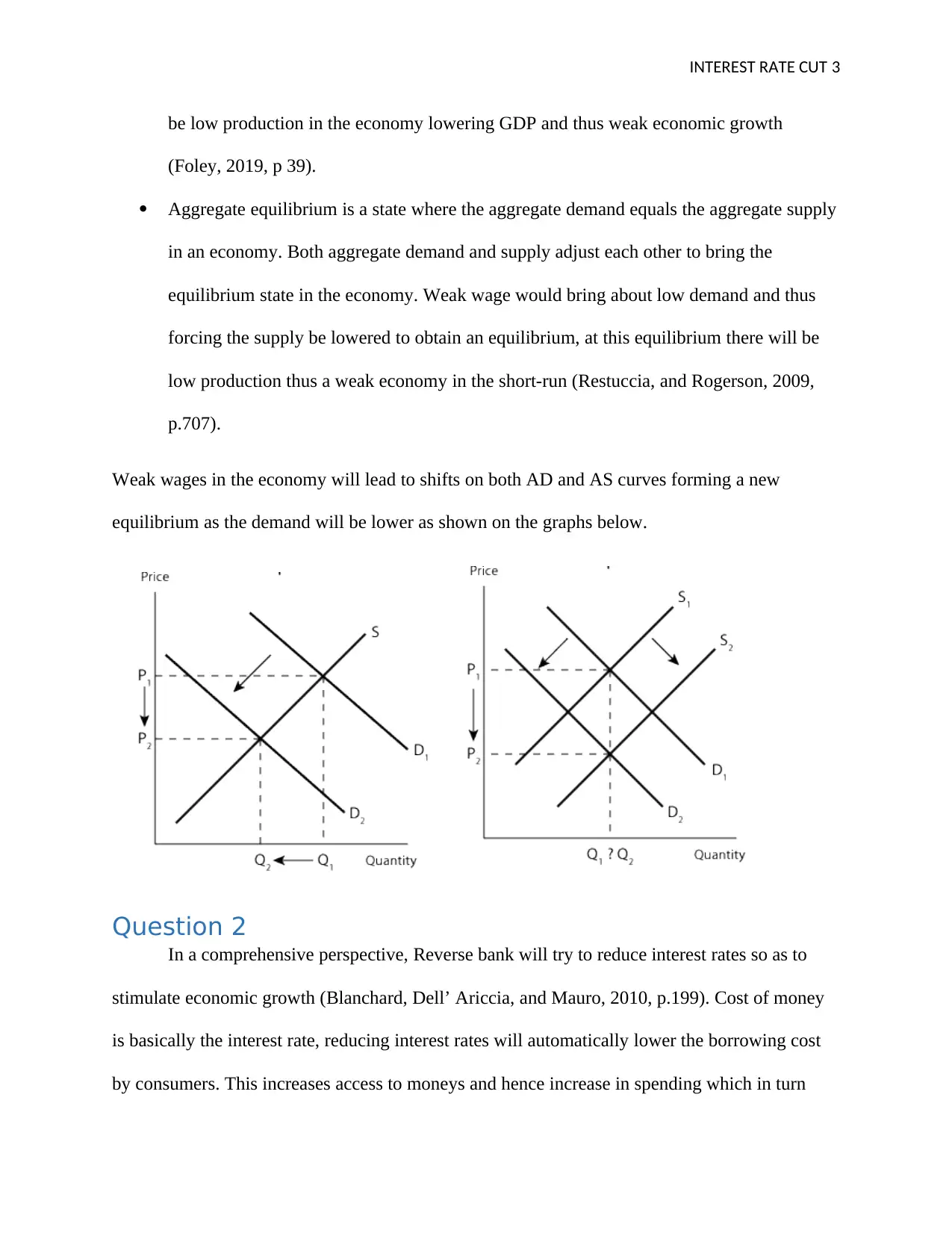
INTEREST RATE CUT 3
be low production in the economy lowering GDP and thus weak economic growth
(Foley, 2019, p 39).
Aggregate equilibrium is a state where the aggregate demand equals the aggregate supply
in an economy. Both aggregate demand and supply adjust each other to bring the
equilibrium state in the economy. Weak wage would bring about low demand and thus
forcing the supply be lowered to obtain an equilibrium, at this equilibrium there will be
low production thus a weak economy in the short-run (Restuccia, and Rogerson, 2009,
p.707).
Weak wages in the economy will lead to shifts on both AD and AS curves forming a new
equilibrium as the demand will be lower as shown on the graphs below.
Question 2
In a comprehensive perspective, Reverse bank will try to reduce interest rates so as to
stimulate economic growth (Blanchard, Dell’ Ariccia, and Mauro, 2010, p.199). Cost of money
is basically the interest rate, reducing interest rates will automatically lower the borrowing cost
by consumers. This increases access to moneys and hence increase in spending which in turn
be low production in the economy lowering GDP and thus weak economic growth
(Foley, 2019, p 39).
Aggregate equilibrium is a state where the aggregate demand equals the aggregate supply
in an economy. Both aggregate demand and supply adjust each other to bring the
equilibrium state in the economy. Weak wage would bring about low demand and thus
forcing the supply be lowered to obtain an equilibrium, at this equilibrium there will be
low production thus a weak economy in the short-run (Restuccia, and Rogerson, 2009,
p.707).
Weak wages in the economy will lead to shifts on both AD and AS curves forming a new
equilibrium as the demand will be lower as shown on the graphs below.
Question 2
In a comprehensive perspective, Reverse bank will try to reduce interest rates so as to
stimulate economic growth (Blanchard, Dell’ Ariccia, and Mauro, 2010, p.199). Cost of money
is basically the interest rate, reducing interest rates will automatically lower the borrowing cost
by consumers. This increases access to moneys and hence increase in spending which in turn
⊘ This is a preview!⊘
Do you want full access?
Subscribe today to unlock all pages.

Trusted by 1+ million students worldwide
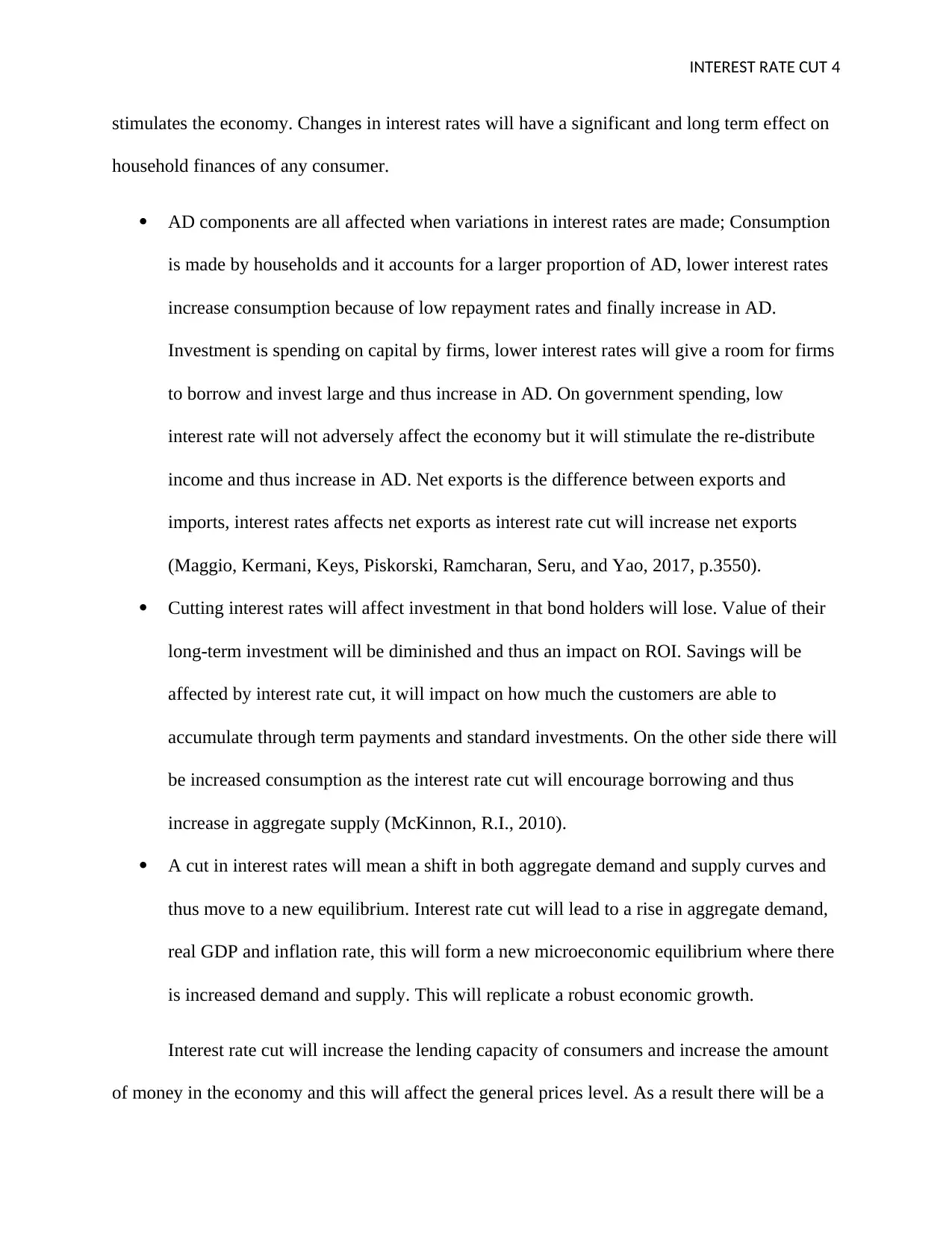
INTEREST RATE CUT 4
stimulates the economy. Changes in interest rates will have a significant and long term effect on
household finances of any consumer.
AD components are all affected when variations in interest rates are made; Consumption
is made by households and it accounts for a larger proportion of AD, lower interest rates
increase consumption because of low repayment rates and finally increase in AD.
Investment is spending on capital by firms, lower interest rates will give a room for firms
to borrow and invest large and thus increase in AD. On government spending, low
interest rate will not adversely affect the economy but it will stimulate the re-distribute
income and thus increase in AD. Net exports is the difference between exports and
imports, interest rates affects net exports as interest rate cut will increase net exports
(Maggio, Kermani, Keys, Piskorski, Ramcharan, Seru, and Yao, 2017, p.3550).
Cutting interest rates will affect investment in that bond holders will lose. Value of their
long-term investment will be diminished and thus an impact on ROI. Savings will be
affected by interest rate cut, it will impact on how much the customers are able to
accumulate through term payments and standard investments. On the other side there will
be increased consumption as the interest rate cut will encourage borrowing and thus
increase in aggregate supply (McKinnon, R.I., 2010).
A cut in interest rates will mean a shift in both aggregate demand and supply curves and
thus move to a new equilibrium. Interest rate cut will lead to a rise in aggregate demand,
real GDP and inflation rate, this will form a new microeconomic equilibrium where there
is increased demand and supply. This will replicate a robust economic growth.
Interest rate cut will increase the lending capacity of consumers and increase the amount
of money in the economy and this will affect the general prices level. As a result there will be a
stimulates the economy. Changes in interest rates will have a significant and long term effect on
household finances of any consumer.
AD components are all affected when variations in interest rates are made; Consumption
is made by households and it accounts for a larger proportion of AD, lower interest rates
increase consumption because of low repayment rates and finally increase in AD.
Investment is spending on capital by firms, lower interest rates will give a room for firms
to borrow and invest large and thus increase in AD. On government spending, low
interest rate will not adversely affect the economy but it will stimulate the re-distribute
income and thus increase in AD. Net exports is the difference between exports and
imports, interest rates affects net exports as interest rate cut will increase net exports
(Maggio, Kermani, Keys, Piskorski, Ramcharan, Seru, and Yao, 2017, p.3550).
Cutting interest rates will affect investment in that bond holders will lose. Value of their
long-term investment will be diminished and thus an impact on ROI. Savings will be
affected by interest rate cut, it will impact on how much the customers are able to
accumulate through term payments and standard investments. On the other side there will
be increased consumption as the interest rate cut will encourage borrowing and thus
increase in aggregate supply (McKinnon, R.I., 2010).
A cut in interest rates will mean a shift in both aggregate demand and supply curves and
thus move to a new equilibrium. Interest rate cut will lead to a rise in aggregate demand,
real GDP and inflation rate, this will form a new microeconomic equilibrium where there
is increased demand and supply. This will replicate a robust economic growth.
Interest rate cut will increase the lending capacity of consumers and increase the amount
of money in the economy and this will affect the general prices level. As a result there will be a
Paraphrase This Document
Need a fresh take? Get an instant paraphrase of this document with our AI Paraphraser
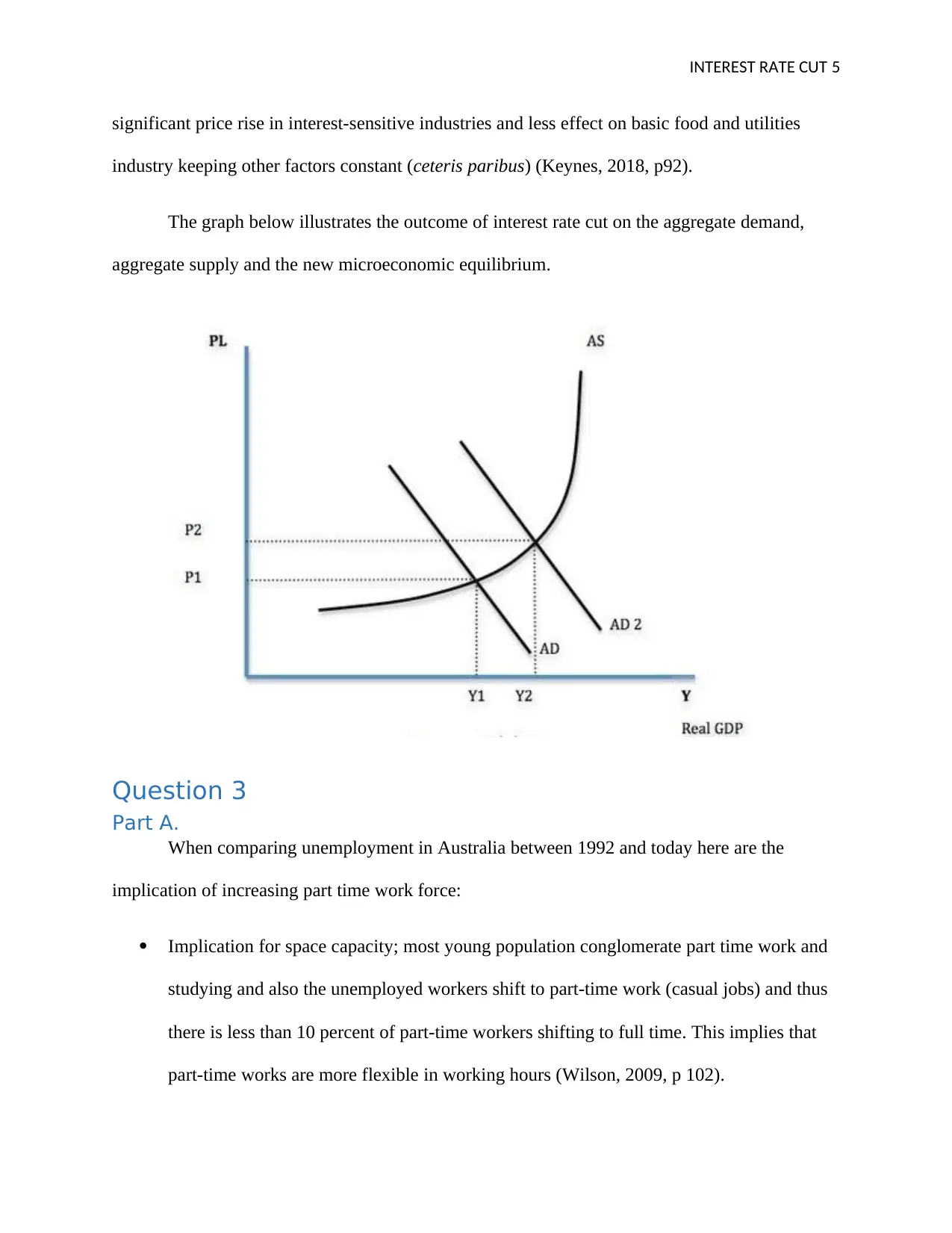
INTEREST RATE CUT 5
significant price rise in interest-sensitive industries and less effect on basic food and utilities
industry keeping other factors constant (ceteris paribus) (Keynes, 2018, p92).
The graph below illustrates the outcome of interest rate cut on the aggregate demand,
aggregate supply and the new microeconomic equilibrium.
Question 3
Part A.
When comparing unemployment in Australia between 1992 and today here are the
implication of increasing part time work force:
Implication for space capacity; most young population conglomerate part time work and
studying and also the unemployed workers shift to part-time work (casual jobs) and thus
there is less than 10 percent of part-time workers shifting to full time. This implies that
part-time works are more flexible in working hours (Wilson, 2009, p 102).
significant price rise in interest-sensitive industries and less effect on basic food and utilities
industry keeping other factors constant (ceteris paribus) (Keynes, 2018, p92).
The graph below illustrates the outcome of interest rate cut on the aggregate demand,
aggregate supply and the new microeconomic equilibrium.
Question 3
Part A.
When comparing unemployment in Australia between 1992 and today here are the
implication of increasing part time work force:
Implication for space capacity; most young population conglomerate part time work and
studying and also the unemployed workers shift to part-time work (casual jobs) and thus
there is less than 10 percent of part-time workers shifting to full time. This implies that
part-time works are more flexible in working hours (Wilson, 2009, p 102).
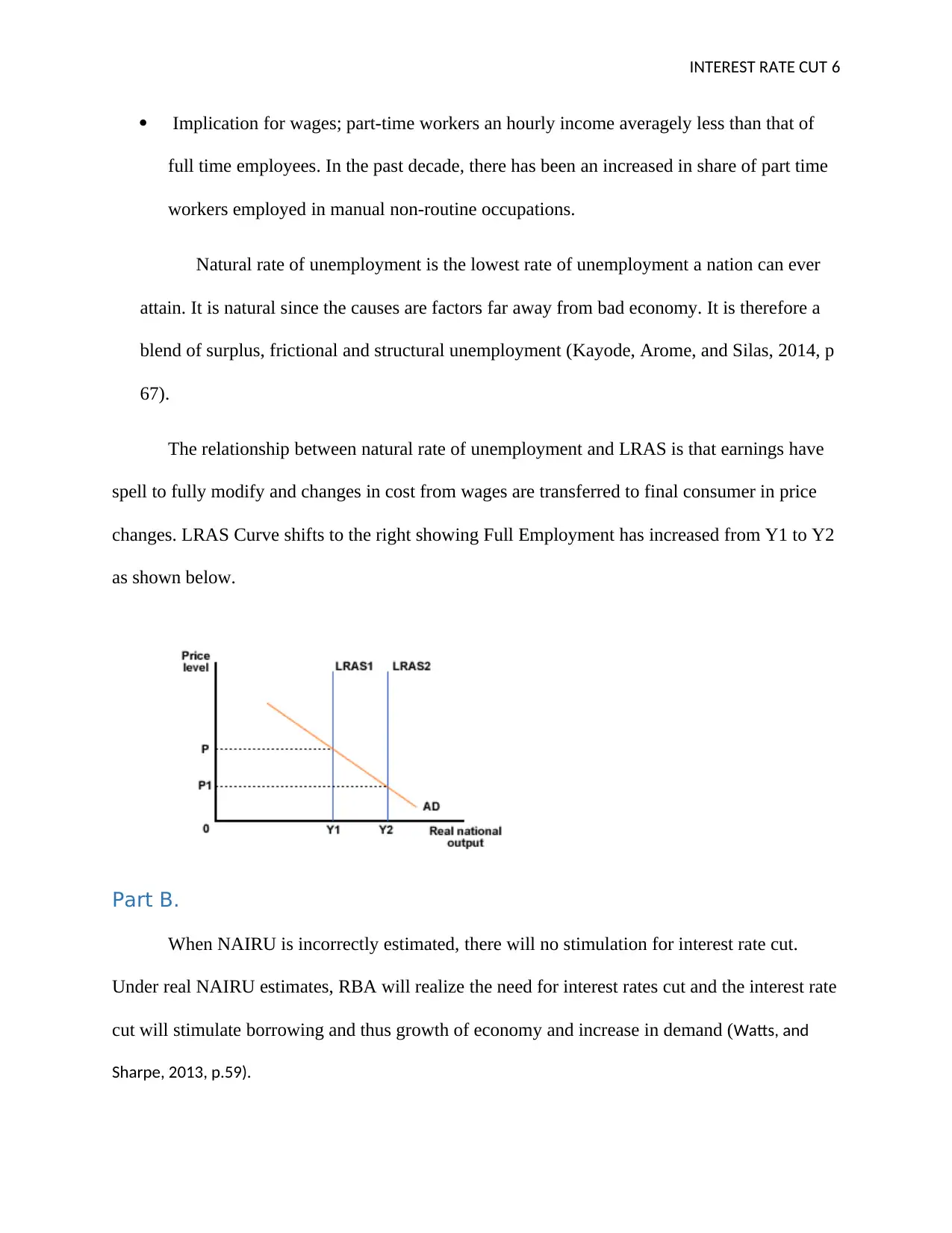
INTEREST RATE CUT 6
Implication for wages; part-time workers an hourly income averagely less than that of
full time employees. In the past decade, there has been an increased in share of part time
workers employed in manual non-routine occupations.
Natural rate of unemployment is the lowest rate of unemployment a nation can ever
attain. It is natural since the causes are factors far away from bad economy. It is therefore a
blend of surplus, frictional and structural unemployment (Kayode, Arome, and Silas, 2014, p
67).
The relationship between natural rate of unemployment and LRAS is that earnings have
spell to fully modify and changes in cost from wages are transferred to final consumer in price
changes. LRAS Curve shifts to the right showing Full Employment has increased from Y1 to Y2
as shown below.
Part B.
When NAIRU is incorrectly estimated, there will no stimulation for interest rate cut.
Under real NAIRU estimates, RBA will realize the need for interest rates cut and the interest rate
cut will stimulate borrowing and thus growth of economy and increase in demand (Watts, and
Sharpe, 2013, p.59).
Implication for wages; part-time workers an hourly income averagely less than that of
full time employees. In the past decade, there has been an increased in share of part time
workers employed in manual non-routine occupations.
Natural rate of unemployment is the lowest rate of unemployment a nation can ever
attain. It is natural since the causes are factors far away from bad economy. It is therefore a
blend of surplus, frictional and structural unemployment (Kayode, Arome, and Silas, 2014, p
67).
The relationship between natural rate of unemployment and LRAS is that earnings have
spell to fully modify and changes in cost from wages are transferred to final consumer in price
changes. LRAS Curve shifts to the right showing Full Employment has increased from Y1 to Y2
as shown below.
Part B.
When NAIRU is incorrectly estimated, there will no stimulation for interest rate cut.
Under real NAIRU estimates, RBA will realize the need for interest rates cut and the interest rate
cut will stimulate borrowing and thus growth of economy and increase in demand (Watts, and
Sharpe, 2013, p.59).
⊘ This is a preview!⊘
Do you want full access?
Subscribe today to unlock all pages.

Trusted by 1+ million students worldwide
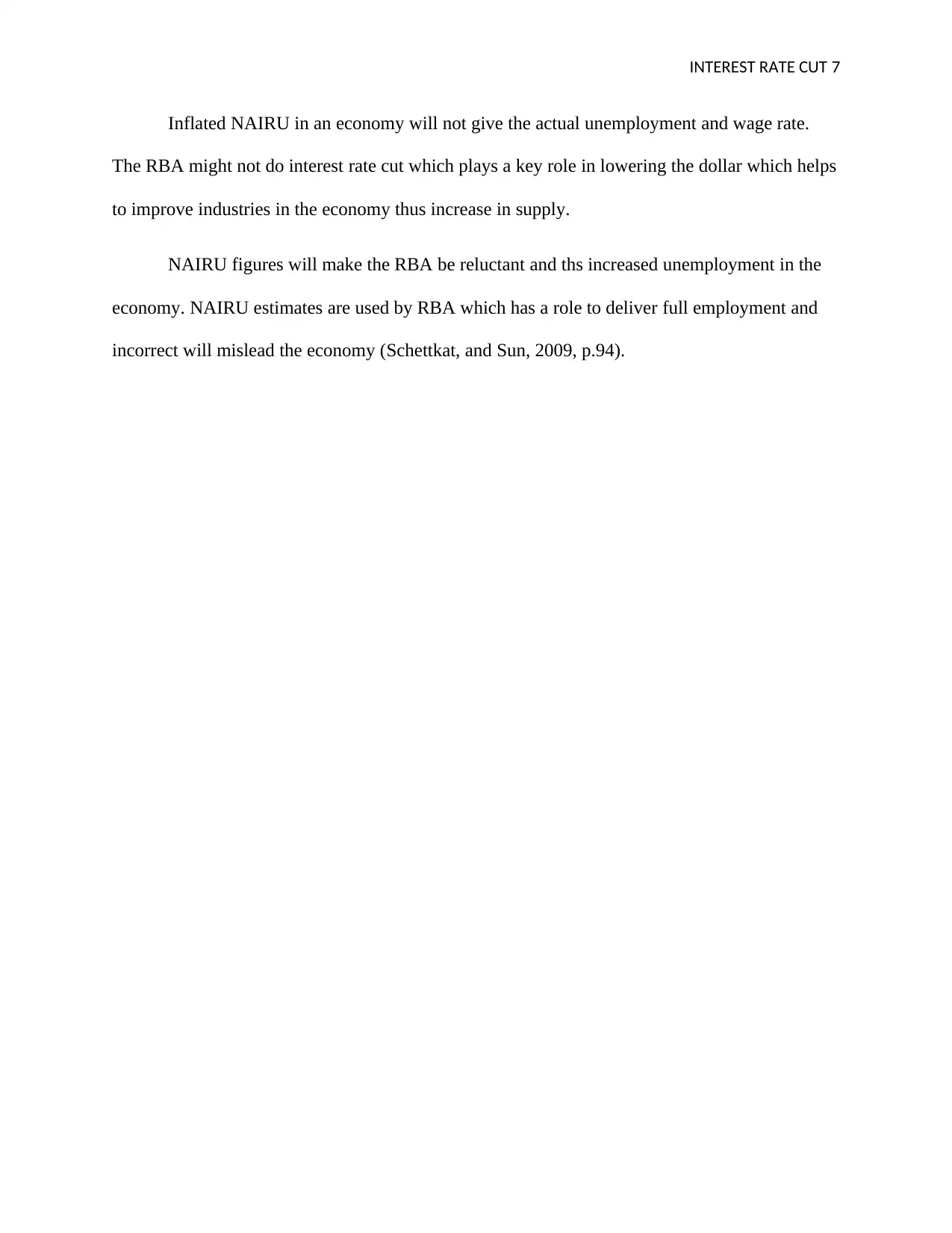
INTEREST RATE CUT 7
Inflated NAIRU in an economy will not give the actual unemployment and wage rate.
The RBA might not do interest rate cut which plays a key role in lowering the dollar which helps
to improve industries in the economy thus increase in supply.
NAIRU figures will make the RBA be reluctant and ths increased unemployment in the
economy. NAIRU estimates are used by RBA which has a role to deliver full employment and
incorrect will mislead the economy (Schettkat, and Sun, 2009, p.94).
Inflated NAIRU in an economy will not give the actual unemployment and wage rate.
The RBA might not do interest rate cut which plays a key role in lowering the dollar which helps
to improve industries in the economy thus increase in supply.
NAIRU figures will make the RBA be reluctant and ths increased unemployment in the
economy. NAIRU estimates are used by RBA which has a role to deliver full employment and
incorrect will mislead the economy (Schettkat, and Sun, 2009, p.94).
Paraphrase This Document
Need a fresh take? Get an instant paraphrase of this document with our AI Paraphraser
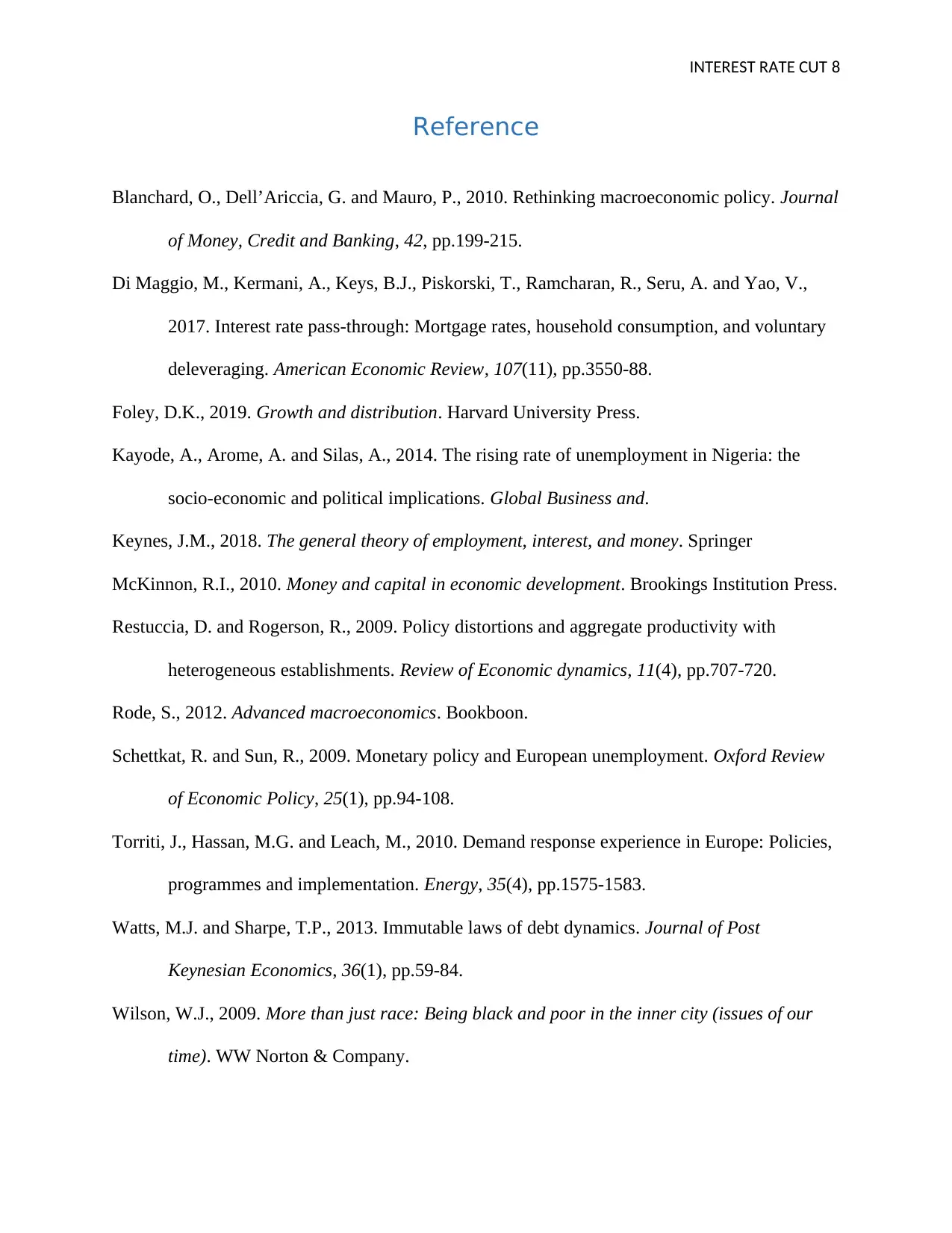
INTEREST RATE CUT 8
Reference
Blanchard, O., Dell’Ariccia, G. and Mauro, P., 2010. Rethinking macroeconomic policy. Journal
of Money, Credit and Banking, 42, pp.199-215.
Di Maggio, M., Kermani, A., Keys, B.J., Piskorski, T., Ramcharan, R., Seru, A. and Yao, V.,
2017. Interest rate pass-through: Mortgage rates, household consumption, and voluntary
deleveraging. American Economic Review, 107(11), pp.3550-88.
Foley, D.K., 2019. Growth and distribution. Harvard University Press.
Kayode, A., Arome, A. and Silas, A., 2014. The rising rate of unemployment in Nigeria: the
socio-economic and political implications. Global Business and.
Keynes, J.M., 2018. The general theory of employment, interest, and money. Springer
McKinnon, R.I., 2010. Money and capital in economic development. Brookings Institution Press.
Restuccia, D. and Rogerson, R., 2009. Policy distortions and aggregate productivity with
heterogeneous establishments. Review of Economic dynamics, 11(4), pp.707-720.
Rode, S., 2012. Advanced macroeconomics. Bookboon.
Schettkat, R. and Sun, R., 2009. Monetary policy and European unemployment. Oxford Review
of Economic Policy, 25(1), pp.94-108.
Torriti, J., Hassan, M.G. and Leach, M., 2010. Demand response experience in Europe: Policies,
programmes and implementation. Energy, 35(4), pp.1575-1583.
Watts, M.J. and Sharpe, T.P., 2013. Immutable laws of debt dynamics. Journal of Post
Keynesian Economics, 36(1), pp.59-84.
Wilson, W.J., 2009. More than just race: Being black and poor in the inner city (issues of our
time). WW Norton & Company.
Reference
Blanchard, O., Dell’Ariccia, G. and Mauro, P., 2010. Rethinking macroeconomic policy. Journal
of Money, Credit and Banking, 42, pp.199-215.
Di Maggio, M., Kermani, A., Keys, B.J., Piskorski, T., Ramcharan, R., Seru, A. and Yao, V.,
2017. Interest rate pass-through: Mortgage rates, household consumption, and voluntary
deleveraging. American Economic Review, 107(11), pp.3550-88.
Foley, D.K., 2019. Growth and distribution. Harvard University Press.
Kayode, A., Arome, A. and Silas, A., 2014. The rising rate of unemployment in Nigeria: the
socio-economic and political implications. Global Business and.
Keynes, J.M., 2018. The general theory of employment, interest, and money. Springer
McKinnon, R.I., 2010. Money and capital in economic development. Brookings Institution Press.
Restuccia, D. and Rogerson, R., 2009. Policy distortions and aggregate productivity with
heterogeneous establishments. Review of Economic dynamics, 11(4), pp.707-720.
Rode, S., 2012. Advanced macroeconomics. Bookboon.
Schettkat, R. and Sun, R., 2009. Monetary policy and European unemployment. Oxford Review
of Economic Policy, 25(1), pp.94-108.
Torriti, J., Hassan, M.G. and Leach, M., 2010. Demand response experience in Europe: Policies,
programmes and implementation. Energy, 35(4), pp.1575-1583.
Watts, M.J. and Sharpe, T.P., 2013. Immutable laws of debt dynamics. Journal of Post
Keynesian Economics, 36(1), pp.59-84.
Wilson, W.J., 2009. More than just race: Being black and poor in the inner city (issues of our
time). WW Norton & Company.
1 out of 8
Related Documents
Your All-in-One AI-Powered Toolkit for Academic Success.
+13062052269
info@desklib.com
Available 24*7 on WhatsApp / Email
![[object Object]](/_next/static/media/star-bottom.7253800d.svg)
Unlock your academic potential
Copyright © 2020–2025 A2Z Services. All Rights Reserved. Developed and managed by ZUCOL.





